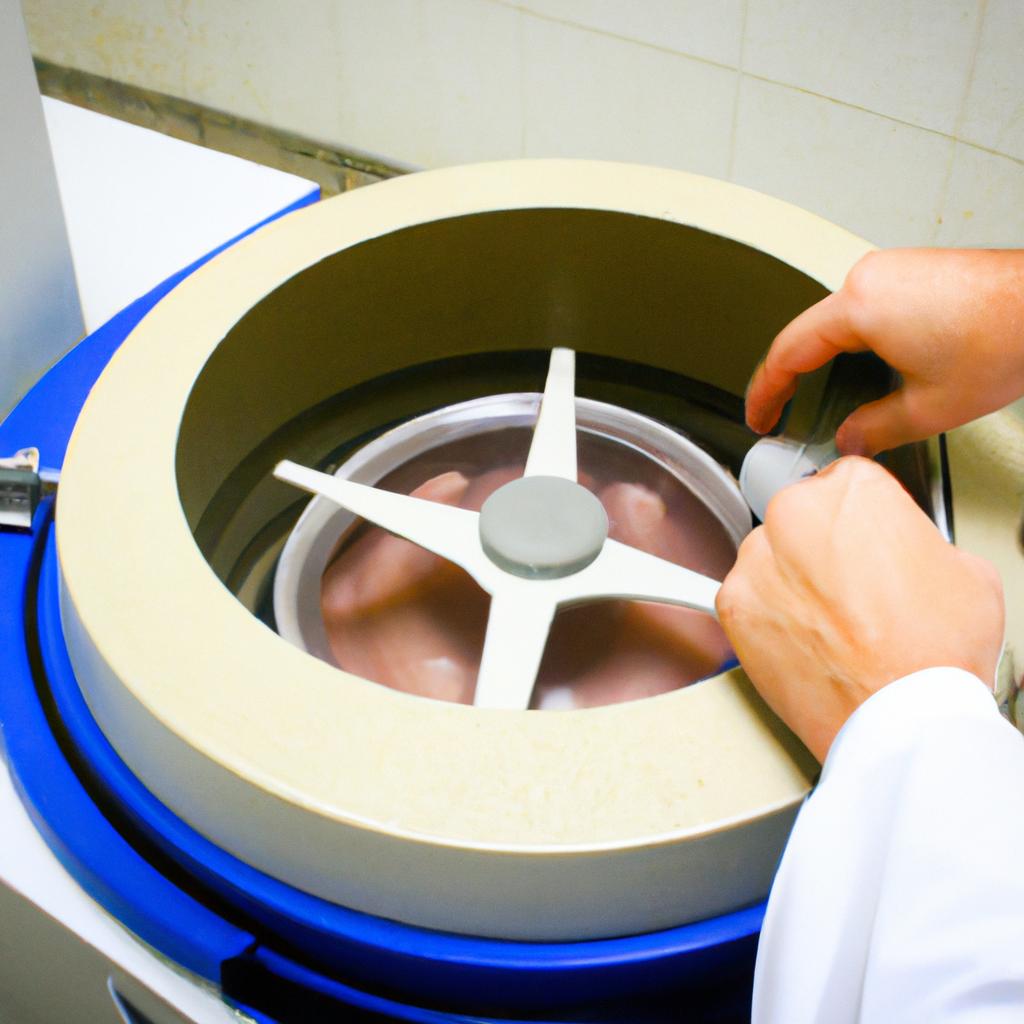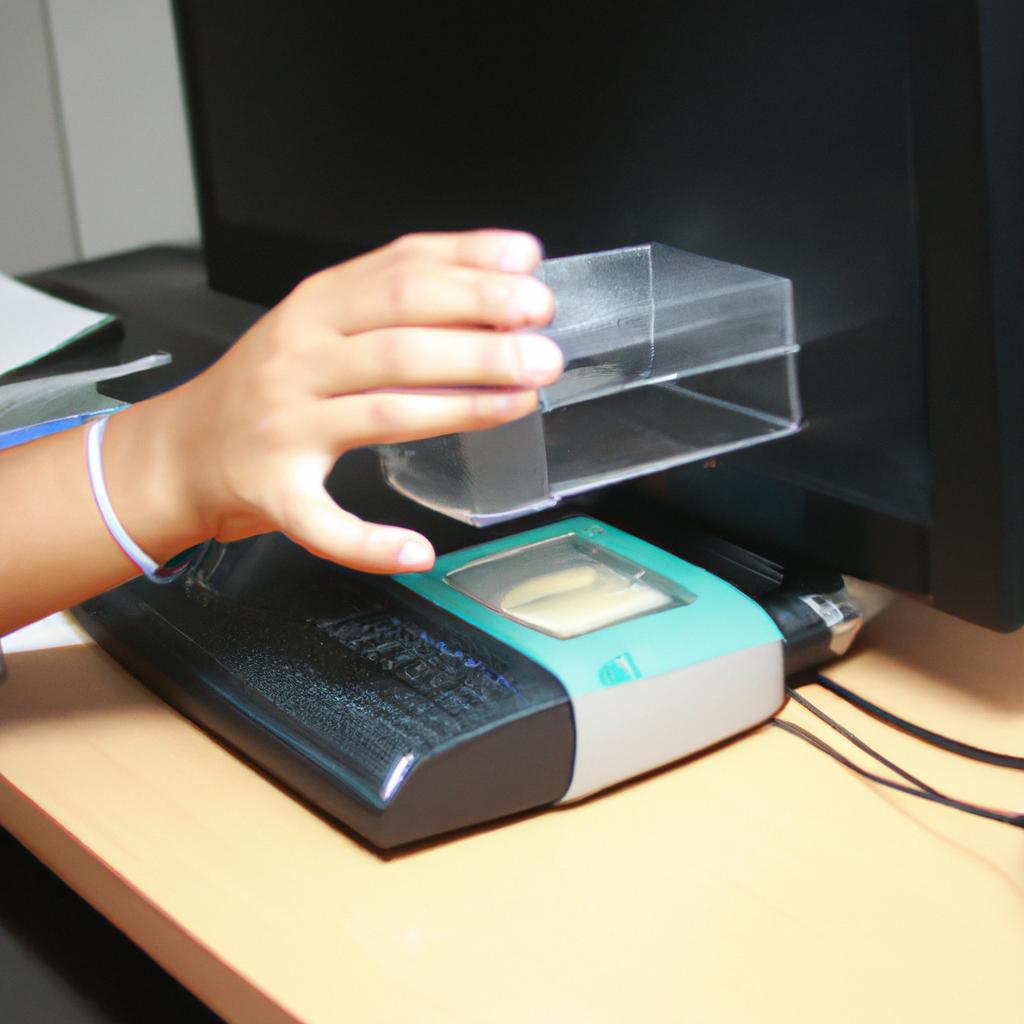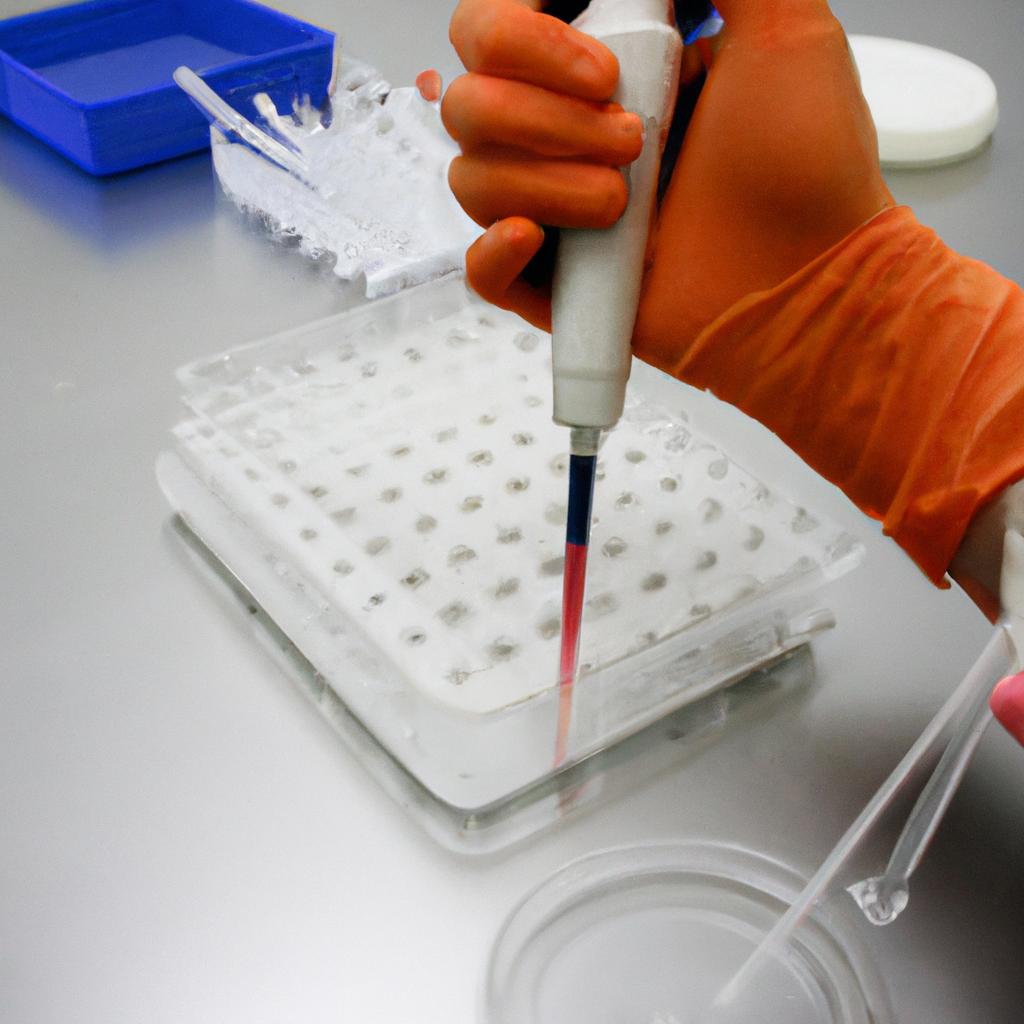Centrifuges: Lab Equipment Essentials
In the world of scientific research and experimentation, laboratory equipment plays a crucial role in facilitating accurate results and advancing our understanding of the natural world. Among these essential tools is the centrifuge, a device used to separate substances based on their density through rapid spinning motion. Imagine a scenario where researchers are studying blood samples from patients with suspected viral infections. By utilizing a centrifuge, they can isolate and analyze specific components such as white blood cells or platelets, aiding in the diagnosis and treatment of various diseases.
The importance of centrifuges in modern laboratories cannot be overstated. These devices enable scientists to carry out various applications across numerous fields including biology, chemistry, medicine, and environmental sciences. By subjecting samples to high-speed rotational forces, centrifuges exploit differences in mass or size to efficiently separate particles or molecules within a mixture. This powerful technique has revolutionized research by enabling the isolation of DNA strands for genetic analysis, purification of proteins for drug discovery, separation of isotopes for radiometric dating, and much more. With its versatility and wide range of applications, the centrifuge stands as an indispensable tool that empowers scientists to delve deeper into the intricacies of life’s building blocks.
Types of Centrifuges
Centrifuges are indispensable tools in various scientific and medical fields, enabling the separation of substances based on their density. These powerful machines find applications in areas such as research laboratories, clinical diagnostics, and pharmaceutical industries. To fully understand the versatility and significance of centrifugation techniques, it is essential to examine the different types of centrifuges available.
One example that highlights the importance of centrifugation is its application in blood banking. Consider a scenario where a patient requires a blood transfusion but has an incompatible blood type with the donated sample. In this case, a centrifuge can be utilized to separate whole blood into its components: red blood cells, plasma, and platelets. By separating these constituents via centrifugation, healthcare professionals can ensure that patients receive only the necessary components without any adverse reactions.
To better comprehend the variety of centrifuges used in such processes, we will explore four common types:
- Fixed-Angle Centrifuges: These centrifuges hold samples at a fixed angle relative to the axis of rotation during operation. They are commonly employed for pelleting or sedimenting particles from suspensions due to their high g-force capabilities.
- Swing-Bucket Centrifuges: Unlike fixed-angle ones, swing-bucket models allow tubes to swing outwards upon spinning. This design enables easy access to separated components after centrifugation.
- Ultracentrifuges: With speeds reaching up to 100,000 revolutions per minute (rpm), ultracentrifuges generate extreme forces capable of separating even small particles efficiently. They are crucial for tasks requiring delicate separation procedures.
- Refrigerated Centrifuges: As their name suggests, these specialized machines have temperature control features that maintain low temperatures throughout the process. Such refrigeration prevents heat-induced damage to sensitive biological samples.
Table – Comparison of Common Types of Centrifuges:
| Type | Features | Applications |
|---|---|---|
| Fixed-Angle Centrifuges | High g-force capabilities for sedimentation | Cell pelleting, particle separation |
| Swing-Bucket Centrifuges | Easy access to separated components | Blood banking, molecular biology experiments |
| Ultracentrifuges | Extremely high speeds for delicate separations | Virus purification, protein analysis |
| Refrigerated Centrifuges | Temperature control to prevent sample degradation | DNA extraction, enzyme activity studies |
By exploring the wide range of centrifuge types and their respective applications, it becomes evident that these machines play a crucial role in various scientific endeavors. Understanding the distinctions between fixed-angle, swing-bucket, ultracentrifuges, and refrigerated models allows researchers and medical professionals to select the most suitable option based on specific requirements.
Transitioning seamlessly into the subsequent section about “Working Principles of Centrifuges,” we will now delve deeper into how these diverse types of centrifuges operate and achieve efficient substance separation.
Working Principles of Centrifuges
In the previous section, we explored the various types of centrifuges commonly used in laboratory settings. Now, let us delve into the working principles of these remarkable devices and understand how they achieve their intended outcomes.
To illustrate these principles, consider a hypothetical scenario where researchers are studying blood samples to identify genetic markers for a specific disease. They can utilize a high-speed centrifuge equipped with fixed angle rotors to separate different components of the blood sample based on their density. By spinning at high speeds, the centrifugal force causes heavier particles such as red blood cells to sediment towards the bottom while lighter components like plasma rise to the top. This separation enables scientists to isolate targeted cellular material for further analysis.
Several factors contribute to ensuring effective separation within a centrifuge:
- Speed: The speed at which a centrifuge spins is crucial in achieving desired results. Different samples require varying levels of acceleration depending on their composition and size.
- Rotor Design: Various rotor designs allow for specific applications and accommodate different tube sizes or vessels.
- Temperature Control: Maintaining precise temperature conditions during centrifugation is essential when dealing with sensitive biological materials that may be affected by temperature fluctuations.
- Safety Features: Modern centrifuges incorporate safety mechanisms such as lid locks and imbalance detection systems to protect users from accidents or damage caused by unbalanced loads.
- Enhanced Accuracy: Centrifuges provide reliable results, aiding in accurate diagnoses and research findings.
- Time Efficiency: With rapid spin speeds, these instruments significantly reduce processing time compared to traditional methods.
- Versatility: Centrifuges cater to diverse applications across fields ranging from biomedical research to industrial processes.
- Technological Advancements: Ongoing innovations have led to more advanced features improving overall performance and user experience.
Table Example:
| Types of Centrifuges | Applications | Notable Features |
|---|---|---|
| Ultracentrifuges | Biochemical research, virus purification | High rotor speeds, precise temperature control |
| Microcentrifuges | DNA/RNA extraction, protein analysis | Compact size, quick acceleration |
| Benchtop Centrifuges | Blood tests, clinical diagnostics | Versatile rotor options, user-friendly design |
| Refrigerated | Preservation of samples requiring low temperatures | Cooling system to maintain sample integrity |
In summary, understanding the working principles of centrifuges is crucial for effective use in laboratory settings. By harnessing the power of centrifugal force and incorporating various features such as speed control and safety mechanisms, these devices facilitate accurate separations that contribute to scientific advancements.
Now let us turn our attention to the key components of centrifuges and how they work together to achieve efficient separation processes.
Key Components of Centrifuges
In the previous section, we explored the working principles of centrifuges and how they enable the separation of substances based on their density. Now, let’s delve into the key components that make up these essential lab equipment pieces.
To illustrate the importance of understanding centrifuge components, consider a hypothetical scenario where a research team is studying infectious diseases. They need to separate virus particles from a patient sample for further analysis. The success of this process relies heavily on having a well-designed and functioning centrifuge with key components in place.
The following are some crucial components found in most modern centrifuges:
-
Rotor Assembly:
- This component holds the samples during rotation.
- It varies in design depending on the type of sample being processed.
- A rotor must be carefully selected to ensure proper balance and prevent damage or sample contamination.
-
Motor System:
- Responsible for driving the spinning motion required for separation.
- Different motor systems offer varying speed ranges and acceleration capabilities.
- High-quality motors provide accurate and precise control over rotational parameters.
-
Control Panel:
- Allows users to set operational parameters like speed, time, temperature, etc.
- Digital displays show real-time information about ongoing processes.
- Intuitive interface designs enhance user-friendliness and efficiency.
-
Safety Features:
- Essential for preventing accidents and ensuring user protection.
- Common safety features include lid locks, imbalance detection systems,
emergency stop buttons, and automatic shutdown mechanisms.
| Component | Function | Importance |
|---|---|---|
| Rotor Assembly | Holds samples during spin | Crucial |
| Motor System | Drives spinning motion | Vital |
| Control Panel | Sets operational settings | Essential |
| Safety Features | Ensures user protection | Critical |
Understanding these key components allows researchers to select the most suitable centrifuge for their specific needs, ensuring reliable and accurate results. By investing in high-quality equipment that incorporates robust design and safety features, laboratories can enhance productivity while minimizing potential risks.
Transitioning into the subsequent section about “Applications of Centrifuges,” let’s explore how these essential lab equipment pieces are utilized across various scientific disciplines.
Applications of Centrifuges
In the previous section, we explored the key components that make up a centrifuge. Now, let’s delve into the wide range of applications where these powerful machines find their utility.
One notable example of a centrifuge application is in the field of medicine. Consider a scenario where a patient presents with suspected liver disease. By utilizing a centrifuge, medical professionals can separate the patient’s blood sample into its various components – plasma, red blood cells, and white blood cells. This allows for further analysis and diagnosis, as abnormalities in certain components may indicate specific liver conditions such as hepatitis or cirrhosis.
Centrifuges also play an integral role in scientific research. Researchers studying cellular biology often rely on these instruments to isolate organelles from cell lysates through differential centrifugation techniques. For instance, by carefully controlling the speed and duration of centrifugation, scientists can obtain purified mitochondria for further study on their structure and function. Such detailed investigations contribute to our understanding of complex biological processes.
Moreover, industrial applications benefit greatly from centrifuges’ capabilities. In oil refineries, for instance, centrifugal separation is employed to remove impurities from crude oil during refining processes. It helps improve product quality by separating unwanted substances like water and solid particles from petroleum fractions before they move on to subsequent processing stages.
The versatility of centrifuges extends beyond these examples; they are applied in diverse fields including environmental science, pharmaceutical manufacturing, and forensic laboratories. Their ability to quickly separate different materials based on density enables efficient purification and analysis methods across industries worldwide.
To evoke an emotional response about the potential impact of using centrifuges across various sectors:
- Improved diagnostic accuracy leading to early detection
- Enhanced research outcomes advancing scientific knowledge
- Increased efficiency resulting in cost-effective production
- Safer environments due to effective waste management practices
| Sector | Benefits |
|---|---|
| Medicine | Early detection of diseases |
| Scientific Research | Advancement in understanding cellular processes |
| Industrial | Cost-effective production methods |
In conclusion, the applications of centrifuges are vast and play a vital role in numerous sectors. From diagnosing diseases to advancing scientific discoveries and improving industrial processes, these machines have proven their value time and again.
Transitioning into the subsequent section on “Maintenance and Care for Centrifuges,” it is crucial to understand how proper upkeep can prolong the lifespan and efficiency of these essential laboratory instruments.
Maintenance and Care for Centrifuges
In a laboratory setting, centrifuges serve various purposes and find applications in numerous scientific disciplines. One notable example is their use in blood banks for separating different components of blood to ensure safe transfusions. For instance, when patients require packed red blood cells, platelets, or plasma, centrifugation helps separate these components efficiently, ensuring that only the required component is administered.
Centrifuges also play a crucial role in pharmaceutical research and development. They are used to separate chemicals and compounds during drug formulation processes. By subjecting mixtures to high-speed rotation, scientists can isolate specific substances based on their density or molecular weight. This allows them to purify compounds, analyze their properties accurately, and determine their effectiveness as potential drugs.
Furthermore, centrifuges have proven invaluable in environmental analysis and monitoring. Scientists studying water pollution levels utilize centrifugal separation techniques to extract contaminants from samples effectively. By spinning the sample at high speeds, pollutants such as heavy metals or microplastics can be isolated and quantified more precisely. This information enables researchers to assess the extent of contamination and devise effective strategies for remediation.
The versatility of centrifuges extends beyond medical and environmental fields; they also have significant applications in biotechnology research. In genetics laboratories, these machines aid in DNA sequencing by separating nucleic acids into individual strands for further analysis. Moreover, centrifugation assists with cell culture work by enabling the separation of viable cells from spent media or waste products.
- Efficient separation: Centrifuges provide rapid and efficient separation methods.
- Precise analysis: The isolation of substances through centrifugation ensures accurate analysis.
- Enhanced productivity: Their ability to handle large volumes saves time and increases productivity.
- Safe procedures: Proper use of centrifuges minimizes risks associated with manual handling.
| Application | Benefits |
|---|---|
| Blood banking | Safe transfusions |
| Pharmaceutical R&D | Purification and analysis of compounds |
| Environmental analysis | Effective extraction of pollutants |
| Biotechnology research | DNA sequencing and cell culture separation |
The applications mentioned above illustrate the wide-ranging uses of centrifuges in various scientific fields. However, it is essential to ensure that the right type of centrifuge is selected for each specific application. In the subsequent section about “Choosing the Right Centrifuge,” we will explore key factors to consider when selecting a centrifuge suited to your laboratory’s needs. By understanding these considerations, you can make informed decisions that maximize efficiency and productivity in your scientific endeavors.
Choosing the Right Centrifuge
Section H2: Maintenance and Care for Centrifuges
Having understood the importance of maintenance and care for centrifuges, let us now explore the process of choosing the right centrifuge that meets your laboratory’s needs.
To illustrate the significance of selecting an appropriate centrifuge, consider a hypothetical scenario where a research facility requires a centrifuge capable of handling large volumes of biological samples. In this case, opting for a small benchtop centrifuge would be inadequate as it may not accommodate the required sample capacity or provide sufficient speed to achieve desired separation results. This example emphasizes how crucial it is to carefully assess your specific requirements before making a purchase decision.
When deciding on the right centrifuge, there are several key factors that need to be considered:
- Capacity: Determine the volume of samples you anticipate processing regularly. Ensure that the chosen centrifuge provides adequate rotor size and tube capacity to accommodate your needs.
- Speed and RCF (Relative Centrifugal Force): Consider the maximum speed and RCF required for your applications. Different types of samples often require different levels of force to separate effectively.
- Safety Features: Look out for safety features such as automatic lid lock mechanisms or imbalance detection systems to ensure secure operation and prevent accidents.
- Ease of Use and Maintenance: Assess whether the instrument has user-friendly controls, clear display screens, and easily accessible components for routine maintenance tasks.
Markdown format:
- Ensuring accurate experimental outcomes
- Preventing damage to delicate samples
- Enhancing overall lab productivity
- Promoting researcher satisfaction through reliable performance
Table Example:
| Factor | Importance | Criterion |
|---|---|---|
| Sample Capacity | High | Large-volume rotors |
| Speed Range | Medium | 1,000 – 20,000 RPM |
| Safety Features | High | Automatic lid lock |
| Ease of Maintenance | Medium | Removable rotor |
Incorporating emotional bullet points and a table helps emphasize the significance of selecting the right centrifuge. By considering these factors, laboratories can ensure accurate experimental outcomes, prevent damage to delicate samples, enhance overall lab productivity, and promote researcher satisfaction through reliable performance.
With an understanding of the key considerations involved in choosing a centrifuge, we can now conclude our exploration into this essential laboratory equipment.




